On the radio airwaves, clashes between financial and broadly defined educational interests are common. But local public-affairs broadcasters don’t allow a lack of deep pockets to prevent their messages from getting out.
In recent months, two long-running local radio shows — Matt Mittan’s “Take a Stand!” and Ned Ryan Doyle’s “Our Southern Community” — temporarily lost their on-air slots, putting the issue into focus locally.
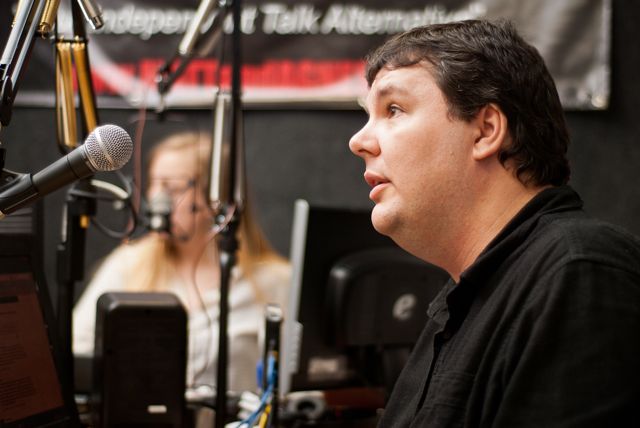
Mittan’s WWNC talk-radio show went down last October after Clear Channel Communications, which owns WWNC and four other Asheville stations, implemented another national round of layoffs that included Mittan’s co-host, Agnes Cheek. Mittan (pictured, with Cheek) quit the same day; in addition to losing Cheek, he rankled under perceived pressure to avoid delving into issues that might offend area politicians or advertisers.
Four months later, Doyle’s program focusing on energy sustainability ended a 10-year run on WNCW, bumped from its time slot by expanded bluegrass programming.
The tension between profitability and public service dates from the beginning of broadcast media. Are the airwaves simply private property, like a piece of real estate? Or are they a shared resource that should “serve the public interest, convenience or necessity,” as the Radio Act of 1927 ambiguously required.
During the debate over the Communications Act of 1934, educators urged setting aside 25 percent of radio frequencies for nonprofit broadcasters. Instead, Federal Communication Commission regulations settled for encouraging broadcasters to present a diversity of voices and programming that the public ought to hear. These regulations, never popular with commercial broadcasters, were largely eliminated by deregulation of radio in the 1980s.
Asheville FM co-founder Greg Lyon describes it this way. “If you look at the history of radio and what the FCC has done, they’ve always had to re-inject [local public-interest programming] into the mix,” he asserts. “Commercial interests discourage stations from providing it. That’s why the FCC keeps opening new frequencies: When they get saturated, this stuff gets pushed to another new area. In the 1960s and ’70s, it migrated from AM stations to FM and public radio.”
Beginning in the 1970s, National Public Radio introduced the possibility of a more community-based alternative. But reduced government support is forcing NPR stations to pay more attention to the bottom line.
Meanwhile, media consolidation and the Internet’s wide-open, no-holds-barred environment have had profound, if conflicting, impacts, concentrating the ownership of traditional news sources in a small number of corporate hands while spawning an almost unlimited number of websites, blogs and other online outlets operating outside mainstream constraints.
Proponents of an unregulated, profit-driven media environment argue that audiences vote with their dollars and will thus get the information they most want.
But what happens to local coverage when programming is prepackaged for regional or national distribution? And what about things that don’t necessarily make money but that help a community know itself, evaluate conflicting views and make informed decisions? The days when Asheville clock radios woke people up to the sound of local-radio icon Scotty Rhodarmer reading obituaries on WWNC are long gone, but new forms of community radio continue to make local voices heard.
Dialing for dollars
An October 2011 Billboard story about the latest Clear Channel layoffs suggests that the firings signaled a corporate shift toward more regional and nationally syndicated programming. Local Clear Channel Vice President Bill McMartin doesn’t disagree with that.
He and Brian Hall, director of news/talk programming at WWNC do, however, flatly deny Mittan’s allegation about censorship. McMartin acknowledges “gaming out” how contentious issues may be received and how to manage negative fallout. He says management tries to ensure in advance that hosts have their facts straight and counsels against creating unnecessary blowback.
Advertisers sometimes pull ads if they don’t like how an issue is covered. Hall adds, “This doesn’t just affect the station. It also impacts the income of ad sales staff who work on commission.”
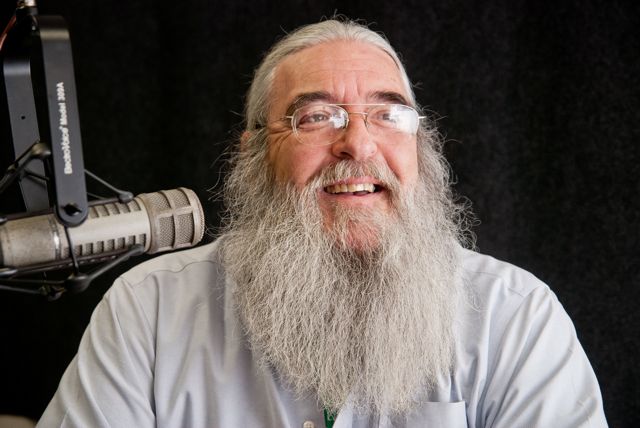
In Doyle’s case, money was certainly a factor: Although he gave his show to WNCW for free, there were fundraising pressures.
Programming Director Dave Kester explains, “Our bluegrass programming is the highest-rated programming we have; we’re constantly bombarded with requests to increase the amount of bluegrass we offer.” Consequently, the station decided to move “Our Southern Community” in order to expand bluegrass show “The Gospel Truth” from three hours to four on Sunday mornings. (Doyle declined an offer of an early Saturday-morning time slot, feeling he wouldn’t have a substantial audience then.)
The move appears to have paid off. WNCW’s 2012 spring pledge drive was the station’s best in eight years. “The Gospel Truth” raised $12,000, with $4,700 of it coming during the added hour. “We had minimal contributions during that hour before,” notes Mike Gavin, the station’s director of marketing and community relations.
Such calculations don’t take place at Asheville NPR station WCQS, according to Executive Director Jody Evans. “I’ve cut programming that was unsuccessful in terms of audience size but not because of pledge results,” she says. “Listeners give when it’s convenient, not when their favorite program is on.”
Last year, WCQS scrapped three long-running local public-affairs shows. “We looked at the audience numbers,” Evans says, and “less than a thousand [people] listened to them.”
There appeared to be need “to move closer to the kind of thing NPR does” and record more news segments outside the station, she says. After the change, “25,000 people heard our interviews with City Council candidates that aired during ‘Morning Edition.’” In the Asheville area, she says, WCQS’s listenership is now second only to 99.9 Kiss Country, and pledge revenues for the station are up 18 percent over the prior year’s numbers.
Deregulation and beyond
For decades, the Federal Communications Commission fast-tracked license renewals for stations that provided what it considered to be an adequate amount of local public-interest programming. But deregulation changed the incentives. Relaxed programming guidelines meant that news and public-affairs programming could be expected to generate a profit.
“Deregulation made it easier for commercial radio to be more bottom-line for shareholders,” says Gavin, adding, “When [WNCW is] bottom-line driven, it’s for survival.”
Barriers to media consolidation were lowered in the 1990s, further transforming the commercial-radio landscape. Clear Channel owned 43 radio stations in 1995; by 2004, that number had ballooned to 1,239.
But the company’s fortunes took a serious downturn in 2008, when a leveraged buyout involving Bain Capital loaded the company with debt. Clear Channel still owns about 850 stations, but despite several rounds of layoffs, it’s scrambling to make the debt payments.
Some NPR member stations also have money woes. In 2009, more than 30 percent of public-radio funding came from universities, federal Corporation for Public Broadcasting grants or direct government support. Now, however, budgetary pressures and eroding support in Washington are forcing stations to rely more on listener donations and private underwriting.
Three years ago, WNCW lost the last of its state funding, which had supplied about 20 percent of the budget. CPB grants still provide 10 to 12 percent, though Kester worries about Congress eliminating them. “The good news about the loss of the state grant was that our listeners stepped up, even at a time when the economy was so bad,” he reports. “But the prospect of having to absorb another 10 percent is a scary proposition.”
CPB grants amount to about 10 percent of WCQS’s budget as well. Listeners, businesses and other local sources cover the remaining 90 percent. “It’s always in the back of our mind as public broadcasters that CPB grants would go away,” Evans says, but this doesn’t discourage her. “Public Radio is expanding all over the country, despite threats to CPB funding,” she says. “We’re all working to build sustainable community stations that don’t rely on funds from outside our own communities.”
Making sense of the world
Money wasn’t what led Doyle to produce more than 400 programs for “Our Southern Community” over 10 years. “What drives me is to contribute to a better future for our children and future generations,” he explains.
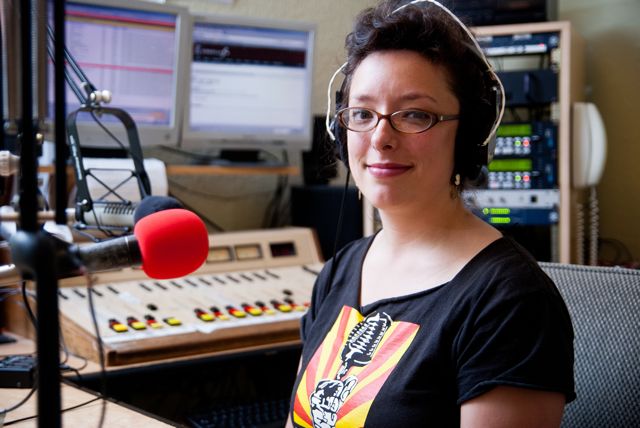
That kind of volunteer commitment is common in community radio. Asheville FM (the initials stand for “Free Media”), an Internet-only station, has no paid staff. Kim Roney (pictured), who volunteers at the station and serves as president of Friends of Community Radio, has volunteered at radio stations for 12 years.
Roney says she puts in 20 to 30 hours per week at the station. While time is her big expense for producing the shows she hosts, Asheville FM also levies a “show dues” charge of $20/month for programs lacking the support of an underwriter.
“It would be awesome if I could pay a general manager at Asheville FM, but I never want to get paid: We’re there for the community,” she says. “It never crossed my mind to consider whether I’m getting taken advantage of. I get so much out of it.”
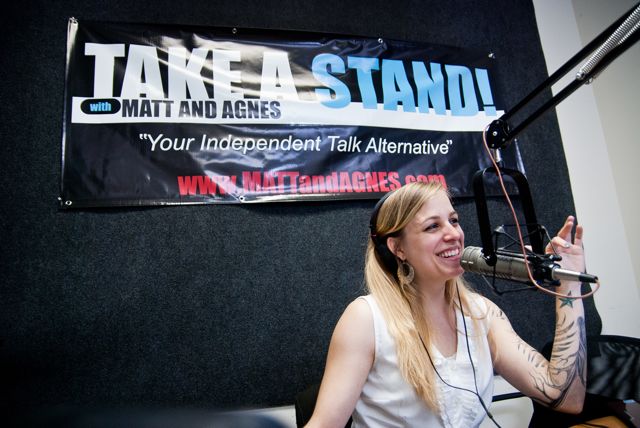
Mittan also began his media career as a volunteer. Though he and Cheek (pictured, left) were paid for their work at WWNC, Cheek says she understands Doyle and Roney’s motivations. “People don’t go into radio for the money. It’s to be able to help people make sense of the world.”
A radical departure
Local community-media pioneer Wally Bowen says, “Any discussion of ‘public-interest’ obligations of broadcasters must first take into account that the existing order of U.S. broadcasting was deliberately imposed by economic and political elites to ensure that broadcast licenses would never fall into the hands of interest groups who might challenge the dominant … order.”
And because Congress never authorized a truly independent federal funding stream, the public-interest sector “is, in many ways, just as centralized and subject to political pressure as commercial broadcasting.”
Bowen, who founded the Asheville-based Mountain Area Information Network and low-power station WPVM, which is now known as MAIN-FM, says MAIN is a nonprofit “in order to avoid the kind of ‘economic censorship’ that occurs when your primary sources of funding come from advertisers or other powerful interests, including government agencies.”
For him, the advent of community-based, nonprofit, low-power FM radio is “a radical departure from the broadcast order established in 1934 … creating a new class of stations that cannot be taken over by for-profit outside interests.”
While Evans is a fan of low-power FM and Internet radio, she’s also a passionate defender of public radio’s community mission. “It’s core to what we do as public broadcasters. I believe in the model. Public radio can be the community voice in a way commercial broadcasters can’t.”
Affecting people’s lives
However much their visions differ, everyone interviewed for this story agreed that radio does have a public-interest responsibility.
“I don’t think there’s a national interest,” says Mittan, “but there’s a local and regional interest nationally.”
Clear Channel’s McMartin says that public-interest programming is “good for business,” in part because “it builds bonds with the community.” The company’s programmers, he notes, can cut and paste from a variety of in-house and other sources, strengthening the connections between individual stations and their listeners.
Mittan has his doubts his former employer’s approach. “It doesn’t sit well with local people and advertisers when the traffic guy they’ve depended on for years just disappears and is replaced by someone in Charlotte,” he says.
Lyon’s take is pragmatic as well. “The only reasons people are going to listen to you are that you’re either worldly good at what you do or you’re providing content that affects people’s lives.” Among other things, Asheville FM prides itself on local and hyperlocal public-affairs content.
At WNCW, the sense of responsibility manifests in a focus on southern-Appalachian musical heritage. “You’ll hear bits and pieces of what we play elsewhere, but not what you can hear on WNCW,” Kester says. “People all over the world listen to our streaming broadcasts; I’ve had pledges from Austria and Russia.”
Keeping it local
In a variety of guises, local public-interest programming appears to be alive and well in Western North Carolina. At WWNC, Pete Kaliner’s talk show took over Mittan’s slot, and Jerri Jameson presents extended news on “The Morning Report.” Over on WPEK, another Clear Channel station, Blake Butler anchors “Local Edge Radio.”
At WCQS, Evans is attempting to recreate something of her success as programming director of Vermont Public Radio. There, she oversaw a gradual newsroom expansion from one staff member to 15. The station is now a news leader in Vermont and a perennial recipient of Edward R. Murrow broadcasting awards. She’s begun the transition here by giving News Director David Hurand a full-time addition to the news staff.
Among local low-power FM stations, WRES aims to serve “people of color and those of low wealth” and also broadcasts Asheville Tourists baseball games. MAIN-FM, which touts a progressive political vision, has several locally produced programs in addition to nationally syndicated fare.
Asheville FM has offered all-local programming online since 2009. The station’s policy about having shows pay their way though “show dues” or underwriting effectively decouples revenue concerns from scheduling decisions. Programs with small or nonwealthy audiences aren’t penalized. The station recently raised almost $13,000 through a Kickstarter campaign, a step toward one day expanding its reach to the local airwaves.
Meanwhile, both Doyle and Mittan have made their way back onto the air, and on multiple stations.
Mittan and Cheek cut a deal to operate Black Mountain-based WZGM-AM in Black Mountain. “Take a Stand!” can be heard live from 3 to 6 p.m., Monday through Friday. It’s also available online and on station affiliates in Brevard, Hendersonville and eastern North Carolina.
Mittan plans to add local public-interest shows to the lineup, splitting ad revenues with affiliates and content providers. Cheek believes that will help attract producers. “We’d like people to make money doing the show they’re passionate about, on air or online,” she explains.
Fans of “Our Southern Community” encouraged Doyle to find a way to keep his show on the air. MAIN-FM and Asheville FM were first to pick it up. As of this month, it also appears in expanded form on WZGM. “What Matt and Agnes are doing is really positive, in my opinion — something of a parallel to [low-power and Internet radio], but on commercial AM,” Doyle says.
“What we’re doing wouldn’t have been possible five years ago,” says Mittan. “Because of the dire financial circumstances [Clear Channel and other major broadcasters are in], they’ve created a hole we can step into and restore community programming.” Besides providing more on-air voices, he notes, “It makes communities more self-sustainable. Instead of sending profits off to service the debt of Bain Capital, we’ll keep the money local.”
Freelance journalist, fiction writer and Asheville resident Michael Hopping can be reached at mike@michaelhopping.com.




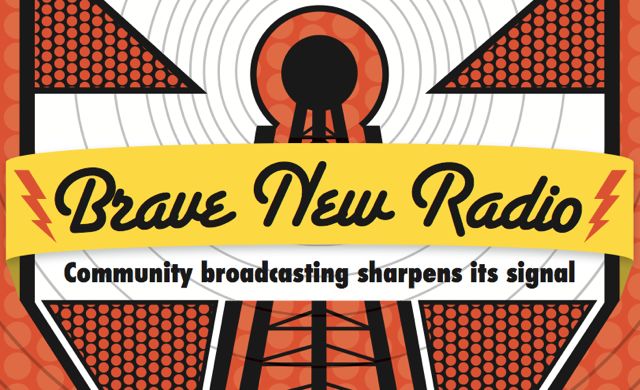
*cough*
http://www.mountainx.com/article/11397/Pirate-station-keeps-flag-flying
communists? anarchists? OMFG!!!!
http://boards.radio-info.com/smf/index.php?action=printpage;topic=5841.0
Cecil Bothwell keeps getting mentioned as someone who stirs up trouble. And now he’s a city councilman.
http://www.mountainx.com/article/12295/Letters-to-the-editor
Funny, the 1998 piece on FRA seems missing from the Xpress archive. I bet you’re going to tell me the same crap I heard from UNCA about old news, aren’t you?